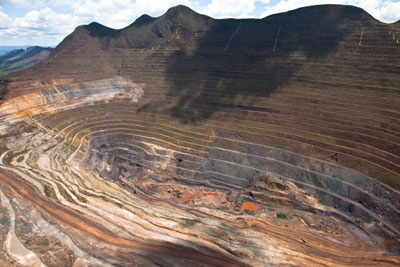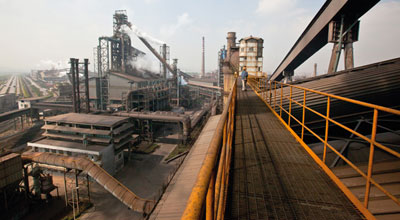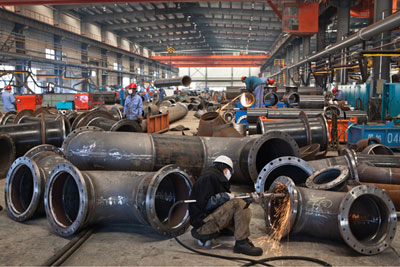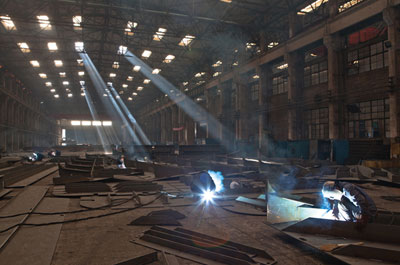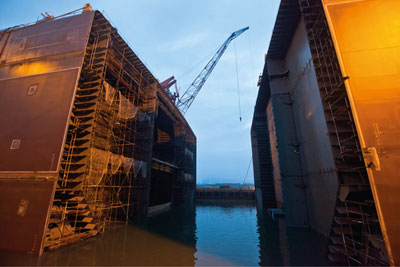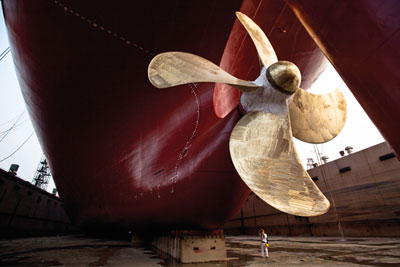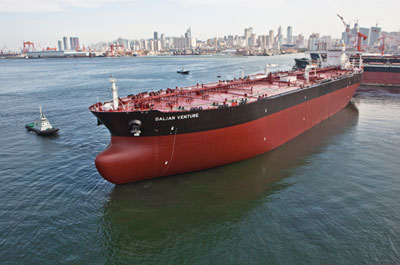中国工业革命的驱动器!
|
钢铁和造船是最能反映中国的非凡增长及转型的两个行业。 这在常驻香港的摄影师鲍皓昕(Basil Pao)的作品《双船记——华光海运60周年纪念册》中被生动地展现出来。本文展出了从纪念册中挑选出来的几张照片,描绘了在中国建造超大油轮和散货船的过程。这些船前往世界各地,装载铁矿石、煤炭和原油,然后返回中国,推动正在那里进行的工业革命。 值得注意的是,就在20年前,中国还是全球钢铁业和造船业的一个相对弱小的竞争者。今天,它是这两个行业的领先者。 钢铁在任何工业国家都是最重要的大宗商品。它是建筑、高速公路、桥梁、铁路等基础设施和各种各样的消费品的重要组成部分。中国成为世界最大的钢铁制造国也许已经是旧闻,但人们容易忘记,这一成就的惊人的实现速度和规模。 在2000年,即开始改革开放22年后,中国的钢铁产量占全球总产量的15%,中国大陆只有两家钢铁公司进入世界前10名。今天,中国生产了全世界大约一半的钢铁,在世界前10大钢铁公司中有5家来自中国,在前20大钢铁公司中中国有10家。 铁矿石消费随着中国的钢铁产量而水涨船高。中国是世界最大的铁矿石生产国,但其矿石含铁量较低,只有大约10%,而进口铁矿石含铁量在60%甚至更高。这也迫使中国成为全球最大的铁矿石进口国,在2012年进口了超过7.4亿吨的铁矿石。 我们来纵向比较一下中国的铁矿石进口:2000年,中国铁矿石进口量为7千万吨,今天进口总量是2000年的10倍以上。再换个角度:今天中国每月的铁矿石进口量都相当于2000年的全年进口总量。澳大利亚、巴西是对中国的主要铁矿石出口国,已经从中国对大宗商品的贪婪消费中获得了巨大的经济利益。 在将铁矿石变成钢的过程中,需要大量的能源。这显然使另一种大宗商品——煤炭——愈发重要。预计从明年开始,全球的燃煤有一半是在中国点燃的。在本世纪的头10年,中国钢产量增加了5倍,煤炭消费量随之增加了3倍。 难怪中国既是世界最大的煤炭生产国,也是最大的进口国。去年(2012年),中国的煤炭进口量年比增加了惊人的57.9%,达到2.89亿吨。尽管中国近年来在绿色能源领域取得了重大进步,但对煤炭的渴求不会在短期内消退。保守估计,在未来4年,煤炭消费总量至少每年增长2%。 除了较少数量的煤炭经由俄罗斯和蒙古陆路运输——只占中国煤炭进口总量的不到9%,大部分进入中国的煤炭出自更加遥远的地方。仅来自印度尼西亚、澳大利亚和南非这三个国家的煤炭就远远超过了中国煤炭进口量的50%。 中国对以海运为主的进口铁矿石和煤炭的需求量极大,令全球造船业自2000年以来、尤其在自2003至2008这几年间获益巨大。需求与租船费用相互促进上涨。然而到了2008年,全球金融危机引发需求暴跌,租借价格从历史高点猛降至接近历史低点。尽管如此,造船业仍然是中国的惊人增长中不可缺少的组成部分。 在过去10年的大部分时间里,中国对大宗散货航运的推动促使全球好望角型(Capesize)散货船队显著增长,好望角型散货船的载重量在15万吨至40多万吨之间。这些船主要用于铁矿石和煤炭的运输,它们一共占到好望角型散货船载货量的90%。 另一类进口越来越多的大宗商品是石油。2012年12月,中国首次成为世界上最大的石油净进口国,但绝对进口数字仍排在美国之后。预计到2015年,中国将超过美国,成为世界上最大的原油进口国。 中国经济对石油越发地渴求,这也带动了超级油轮的制造,有些油轮可以携带200万桶石油。它们在运输效率上排名第二,仅次于石油管道。 自2000年以来,中国对铁矿石、煤炭和石油的需求一直在飞速上涨,再加上钢铁生产的普遍好转,为中国取得造船业全球领先地位创造了绝佳的平台。在2000年,中国还远落后于造船强国韩国和日本,但如今,它已是世界最大的造船国。中国造船上一次领先于世界是在15世纪初的明朝永乐时期,当时郑和带领庞大的宝船舰队从中国航行到东南亚和东非。 造船和用船是两个完全不同的概念。香港最有实力的船王所拥有的技术在造船方面毫无价值。赵氏、辜氏、包氏、曹氏、董氏等家族掌握了风向变化的知识,在20世纪40年代末从上海迁至香港。半个世纪过后,他们又回来推动中国的对外贸易开放。 今天,越来越多的铁矿石和煤炭经由中国制造的好望角型散货船运输,它们使用的燃料是由中国制造的超级油轮进口来的。铁矿石和煤炭被用于生产钢铁,钢铁反过来又用于制造更多的船,带来更多的铁矿石、煤炭和石油……如此循环不息。这些就是交织在中国的发展故事中的主要线索,它们至今仍没有显示出将在短期内衰退的可能。(财富中文网) 译者:古正 照片选自《双船记——华光海运60周年纪念册》,重印得到了鲍皓昕和华光海运的许可。摄影:鲍皓昕。Studio 8版,2012年10月。 |
No two industries better reflect China's extraordinary growth and transformation than steel-making and shipbuilding. This is dramatically illustrated in the book "A Tale of Two Ventures – Wah Kwong at 60", by Hong Kong-based photographer Basil Pao. Selected photos from that book are presented here , depicting the construction of super-sized tankers and bulk carrier ships in China, their journey around the world to obtain cargoes of iron ore, coal, and crude oil, and their return journeys to China to fuel her ongoing industrial revolution. It is useful to bear in mind that just 20 years ago, China was a relatively small player on the global stage in steel-making and shipbuilding. Today it is the leader in both. Steel is one of the most important commodities in any industrialized country. It is a crucial component of infrastructure such as buildings, highways, bridges, railways and a wide range of consumer goods. China's emergence as the world's largest steel-producing country may be old news, but it's easy to forget the remarkable speed and scale of this achievement. In 2000, just 22 years after the launch of the reform and open policy, China's steel production accounted for 15 percent of global output, with only two mainland steelmakers in the top 10. Today it produces roughly half of the world's steel and is home to five of the top 10 steel companies, and 10 of the top 20. Iron ore consumption goes hand in hand with China's steel production. China is the world's top iron ore producer, but the low iron content of its ore – around 10 percent compared to 60 percent or more in imported ore – has forced it to become the world's top importer, bringing in more than 740 million metric tons in 2012. To put the growth of China's iron ore imports into perspective, today's totals are more than ten times the 70 million metric tons it imported in 2000. Viewed another way, today China is importing nearly as much iron ore every month as it did in the entirety of 2000. Australia and Brazil, the main exporters of iron ore to China, have reaped significant economic benefits from China's ravenous consumption of the commodity. The process of turning all that iron ore into steel requires substantial amounts of energy. This is where the increasing importance of another commodity – coal – becomes apparent. It is projected that beginning next year, half of the coal burned in the world will be burned in China. In this century's first decade, the fivefold growth in China's steel output was accompanied by a threefold increase in coal consumption. No wonder that despite being the world's largest producer of coal, China is also the largest importer. Last year [2012] China's coal imports jumped a remarkable 57.9 percent year-on-year, reaching 289 million metric tons. Despite major recent advances in China's green energy sector, the country's hunger for coal is unlikely to wane anytime soon – conservative estimates have its total coal consumption growing by at least two percent annually over the coming four years. Aside from relatively minor amounts coming overland from Russia and Mongolia – less than nine percent of its total imports – the majority of coal entering China comes from much further afield. Well over half of China's coal imports come from just three countries: Indonesia, Australia and South Africa. China's voracious appetite for imported iron ore and coal, most of which comes from overseas, has been a huge boon for the global shipping industry since 2000, most notably in the years between 2003 and 2008. Increased demand and charter rates turned out to be a mixed blessing however – when the 2008 global financial crisis triggered a collapse in demand and charter rates plummeted from an all-time record high to near-record lows. Nevertheless, shipping today is still integral to China's phenomenal growth story. China's impact on bulk shipping during the fat years of the previous decade contributed to significant growth in the global fleet of Capesize bulk carriers, which feature payloads ranging from 150,000 to more than 400,000 long tons deadweight. These ships are primarily used for transport of iron ore and coal, which together constitute around 90 percent of Capesize bulk cargo. Another commodity which China has been importing in increasingly large volumes is oil l. China was the world's largest net oil importer for the first time in December 2012, but in absolute numbers it is still runner-up to the United States. It is expected to surpass the US as the world's top crude importer by 2015. The Chinese economy's growing thirst for oil has had also driven the manufacture of supertanker ships, some of which can carry up to two million barrels of oil. They are second in transport efficiency only to oil pipelines. Since 2000 the skyrocketing demand in China for iron ore, coal and oil combined with a massive upturn in steel production created a perfect platform for the country to take the global lead in shipbuilding. China lagged well behind shipbuilding powerhouses South Korea and Japan in 2000, but today is the world's top shipbuilder. The last time China led the world in shipbuilding was during the days of Ming emperor Yongle at the beginning of the 15th Century, when Zheng He's massive flotillas of treasure ships sailed from China to Southeast Asia and East Africa. Building ships and using ships are two very different propositions. That is where the expertise of Hong Kong's most powerful shipping dynasties has been invaluable. Possessing a knack for knowing which ways the winds of change would blow, the Chao, Koo, Pao, Tsao and Tung families relocated from Shanghai to Hong Kong in the late 1940s, returning half a century later to facilitate China's opening up to global trade. Today more and more iron ore and coal transported by Chinese-made Capesize bulk vessels running on fuel imported by Chinese-made supertankers is used to produce steel that is in turn used to manufacture more ships that bring in more iron ore, coal and oil… and the cycle continues. These are key threads intertwined with the narrative of China's development, and they show no likelihood of abating anytime soon. Photos reprinted with permission of Basil Pao and Wah Kwong Shipping, from "A Tale of Two Ventures – Wah Kwong at 60". Photographs by Basil Pao. Studio 8 Editions , October, 2012. |






